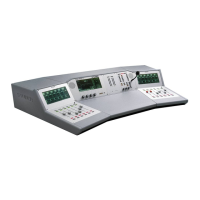External PSU for OnAir 2000
Date printed: 12.11.03 External PSU E3
1 EXTERNAL PSU FOR ONAIR 2000
1.1 Utilization for the Purpose Intended
The External Power Supply Unit (PSU) for Studer OnAir 2000 and OnAir
2000M2 mixing consoles with redundant supply option is intended for pro-
fessional use.
It is presumed that the unit is operated only by trained personnel. Servicing
is reserved to skilled technicians.
The electrical connections may be connected only to the voltages and sig-
nals designated in this manual.
1.2 First Steps
1.2.1 Unpacking and Inspection
Your new equipment is shipped in a special packing, protecting it against
mechanical shock during transit. Care should be exercised when unpacking
so that the surfaces do not get marred.
Verify that the content of the packing agrees with the items listed on the
enclosed shipping list.
Check the condition of the equipment for signs of shipping damage. If
there should be any complaints you should immediately notify the for-
warding agent and your nearest Studer distributor.
Please retain the original packing material because it offers the best pro-
tection in case your equipment ever needs to be transported.
1.2.2 Installation
Primary Voltage: The External PSU is auto-ranging; it can be used for mains voltages in a
range of 100 to 240 V
AC
, 50 to 60 Hz.
General Precautions: Do not use the unit in conditions of excessive heat or cold, near any source
of moisture, in excessively humid environments, or in positions where it is
likely to be subjected to vibration or dust. The ambient temperature range
for normal operation of the unit is +5...+40° C.
Unobstructed air flow is essential for proper operation. The air vents on
the sides of the unit are a functional part of the design and must not be
blocked in any way.
Cleaning: Do not use any liquids to clean the exterior of the unit. A soft, dry cloth or
brush will usually do.
Power Connection: The attached female IEC 320/C13 mains cable socket has to be connected
to an appropriate mains cable by a trained technician, respecting your local
regulations. Refer to the “Installation, Operation, and Waste Disposal”
chapter at the beginning of this manual.

